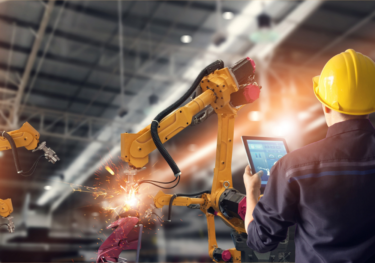Blog | 04 Mar 2021
The pandemic is accelerating the rise of the robots and changing work forever

Matthew Tinsley
Lead Economist, Economics & Sustainability

The COVID-19 pandemic has changed the nature of work dramatically over the last 12 months. Practices that would have seemed unthinkable just a year ago are increasingly commonplace, like the South Korean hospitals that have robots disinfecting surfaces and enforcing social distancing rules. Whilst many of the direct implications of the pandemic are likely to fade once it passes, one of its most significant legacies might end up being how much it accelerates other trends, in particular the rise of robotics and automation.
The growth of robotics in industry is not a new idea. Our 2019 report, How Robots Change the World, examined the dichotomy that it presents in detail. While automation gives economies valuable opportunities to become more productive and achieve long-run growth, it will also cause many occupations to change or disappear, creating difficult dislocations for many people. The scale of this impact should not be underestimated—our forecast suggests that industrial robots could displace 20 million jobs globally by 2030, equal to 8.5% of the total manufacturing workforce.
The pandemic has accelerated this trend, with social distancing and working from home incentivising businesses to invest in automation faster than they may have otherwise planned. Robotics orders grew sharply in late 2020, with experts forecasting rapid growth in 2021. Crucially, investors are backing robotics companies and fuelling their expansion. The index in the chart below shows how share prices and stock values are increasing rapidly, having doubled in 2020, with this trend appearing to accelerate in early 2021.
 Investments in robotics and automation represent significant capital outlays and should therefore be seen as a permanent change in the way that many businesses operate. This has the potential to leave many people out in the cold, with occupations that existed before the pandemic not in demand after it. And for many people, changing careers will be extremely difficult: Previous work by Oxford Economics showed that these transitions create significant skills gaps, where available workers do not have the skills employers require. These skills matching issues might be even more acute due to the pandemic given the limitations on peoples’ movement and a weak economy.
Investments in robotics and automation represent significant capital outlays and should therefore be seen as a permanent change in the way that many businesses operate. This has the potential to leave many people out in the cold, with occupations that existed before the pandemic not in demand after it. And for many people, changing careers will be extremely difficult: Previous work by Oxford Economics showed that these transitions create significant skills gaps, where available workers do not have the skills employers require. These skills matching issues might be even more acute due to the pandemic given the limitations on peoples’ movement and a weak economy.
Whilst we expect workers to find their way back into employment eventually, and for robotics to improve the overall economic outlook, a number of people might still be left working below their potential. This will affect not only the livelihoods of workers whose industries are disrupted, but prevent economies from maximising the benefits of robotics.
Support is therefore needed to help people make this transition, and ensuring that people and their economic potential are not left behind. It will require concerted political effort and commitment, with education, employment support and industrial policy all needing to pull in the same direction. Our research shows that both technical and on-the-job training are likely to be required to bridge the skills gap. The countries that rise to these challenges will be best placed to thrive in the post-pandemic world.
Tags:
You may be interested in

Post
Oxford Economics enhances its Commodity Price Forecasts coverage
Oxford Economics expands Commodity Price Forecasts service to include battery metals, agricultural commodities and plastics.
Find Out More
Post
Oxford Economics Expands Regional Presence with the Launch of Chinese Website
Over the past six years we've maintained the unique modelling and analysis that clients and the media have come to rely on from BIS Shrapnel while incorporating Oxford Economics' rigorous global modelling and analytical framework to complement it," said David Walker, Director, Oxford Economics Australia.
Find Out More
Post
Oxford Economics Introduces Proprietary Data Service
Oxford Economics is excited to enrich its suite of asset management solutions with the introduction of the Proprietary Data Service.
Find Out More